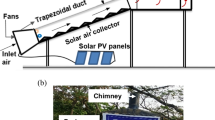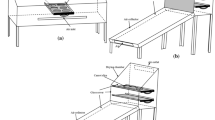Abstract
Drying experiments have been performed with potato cylinders and slices using a laboratory scale designed natural convection mixed-mode solar dryer. The drying data were fitted to eight different mathematical models to predict the drying kinetics, and the validity of these models were evaluated statistically through coefficient of determination (R2), root mean square error (RMSE) and reduced chi-square (χ 2). The present investigation showed that amongst all the mathematical models studied, the Modified Page model was in good agreement with the experimental drying data for both potato cylinders and slices. A mathematical framework has been proposed to estimate the performance of the food dryer in terms of net CO2 emissions mitigation potential along with unit cost of CO2 mitigation arising because of replacement of different fossil fuels by renewable solar energy. For each fossil fuel replaced, the gross annual amount of CO2 as well as net amount of annual CO2 emissions mitigation potential considering CO2 emissions embodied in the manufacture of mixed-mode solar dryer has been estimated. The CO2 mitigation potential and amount of fossil fuels saved while drying potato samples were found to be the maximum for coal followed by light diesel oil and natural gas. It was inferred from the present study that by the year 2020, 23 % of CO2 emissions can be mitigated by the use of mixed-mode solar dryer for drying of agricultural products.







Similar content being viewed by others
Abbreviations
- a,b,c:
-
Coefficients in thin layer model
- k, k0, k1, g, n:
-
Constants in the model
- Aa :
-
Aperture area of solar dryer (m2)
- Ca, :
-
Net annual cost of the solar dryer (Rs)
- CEF:
-
Carbon emission factor of fuel
- Cp :
-
Specific heat capacity of the product (J/kg K)
- CRFd,T :
-
Capital recovery factor
- CUF:
-
Capacity utilization factor of solar dryer
- d:
-
Discount rate in fraction
- Em :
-
CO2 emissions embodied in the solar dryer (kg/m2)
- Ep :
-
Specific energy required for drying the product (kJ/kg dry matter)
- FCO:
-
Fraction of carbon oxidized during combustion of fuel
- fi :
-
Fraction of crop currently being dried by ith fuel
- fpp :
-
Correction factor for the purchasing power of the user
- fr :
-
Fraction of crop used in raw form
- fsol :
-
Correction factor for solar radiation availability
- GEc :
-
Potential of mitigating gross fossil CO2 emissions (kg)
- MRexp,i :
-
Experimental moisture ratio (dimensionless)
- MRpre,i :
-
Predicted moisture ratio (dimensionless)
- M:
-
Moisture content, dry basis (kg water/kg dry matter)
- M0 :
-
Initial moisture content
- Me :
-
Equilibrium moisture content
- m:
-
Annual operation and maintenance cost of solar dryer as a fraction of its capital cost
- N:
-
Total no of observations
- n:
-
Number of constants
- NEc :
-
Net annual potential of CO2 emissions mitigation (kg)
- pc :
-
Cost of the solar dryer per unit aperture area (Rs/m2)
- Qdry :
-
Potential amount of a cash crop for solar drying (kg)
- Qgross :
-
Gross annual crop production (kg)
- R2 :
-
Coefficient of determination
- RMSE:
-
Root mean square error
- χ2 :
-
Reduced chi square
- T:
-
Useful life time of the solar dryer (years)
- Tp :
-
Temperature of product (K)
- t:
-
Drying period
- UCdry :
-
Unit cost of solar crop drying (Rs/kg)
- UCmit :
-
Unit cost of fossil CO2 emissions mitigation (Rs/kg)
- ηd :
-
Thermal efficiency of the solar dryer
- ηi :
-
Efficiency of utilization of ith fuel in a conventional dryer
- λ:
-
Latent heat of vaporization (kJ/kg)
- o:
-
At the beginning of drying
- f:
-
Final value of moisture content
References
ADB (1998) Asia Least-Cost Greenhouse Gas Abatement Strategy (ALGAS) India. Asian Development Bank (ADB), Manila
Afzal TM, Abe T (2000) Simulation of moisture changes in barley during far infrared radiation drying. Comput Electron Agric 26:137–145
Aghbashlo M, Kianmehr MH, Arabhosseini A (2009) Modeling of thin-layer drying of potato slices in length of continuous band dryer. Energy Convers Manage 50(5):1348–1355
Akpinar E, Midilli A, Bicer Y (2003) Single layer drying behaviour of potato slices in a convective cyclone dryer and mathematical modeling. Energy Convers Manage 44(10):1689–1705
Akpinar EK (2010) Drying of mint leaves in a solar dryer and under open sun: modelling, performance analyses. Energy Convers Manage 51(12):2407–2418
Akpinar EK, Bicer Y (2008) Mathematical modelling of thin layer drying process of long green pepper in solar dryer and under open sun. Energy Convers Manage 49:1367–1375
Almuhanna EA (2011) Utilization of a solar greenhouse as a solar dryer for drying dates under the climatic conditions of the eastern province of Saudi Arabia. Part I. Thermal performance analysis of a solar dryer. J Agr Sci 4(3):237–246
AOAC (2002) Official methods of analysis, 17th edn. Association of Official Analytical Chemists, Arlington
Arata A, Sharma VK, Spagna G (1993) Performance evaluation of solar assisted dryers for low temperature drying application-II Experimental results. Energy Convers Manage 34(5):417–426
Bolaji BO, Olalusi AP (2008) Performance evaluation of a mixed-mode solar dryer. AU J Tech 11(4):225–231
Chayjan RA, Parian JA, Esna-Ashari M (2011) Modeling of moisture diffusivity, activation energy and specific energy consumption of high moisture corn in a fixed and fluidized bed convective dryer. Span J Agric Res 9(1):28–40
Darvishi H, Asl AR, Asghari A, Najafi G, Gazori HA (2013) Mathematical modeling, moisture diffusion, energy consumption and efficiency of thin layer drying of potato slices. J Food Process Technol 4:215
Dubey S, Tiwari GN (2009) Analysis of PV/T flat plate water collectors connected in series. Sol Energy 83:1485–1498
Eswara AR, Ramakrishnarao M (2013) Solar energy in food processing-a critical appraisal. J Food Sci Technol 50(2):209–227
Fadhel MI, Abdo RA, Yousif BF, Zaharim A, Sopian K (2011) Thin-Layer drying characteristics of banana slices in a force Convection indirect solar drying, Recent researches in Energy and Environment. In: EE 2011: 6th IASME/WSEAS International Conference on Energy and Environment, 23–25 Feb 2011, Cambridge, United Kingdom
FAO (2010) Food and Agriculture Organization of the United Nations. http://www.fao.org. Accessed 26 Feb 2013
Forson FK, Nazha MAA, Rajakaruna H (2007) Modelling and experimental studies on a mixed-mode natural convection solar crop dryer. Sol Energy 81(3):346–357
Gunhan T, Demir V, Hancioglu E, Hepbasli A (2005) Mathematical modelling of drying of bay leaves. Energy Convers Manage 46(11–12):1667–1679
Henderson SM (1974) Progress in developing the thin layer drying equation. Trans ASAE 17:1167–1172
Islam MN, Flink JM (1982) Dehydration of potato. I. Air and solar drying at low air velocities. J of Food Technology 17:373–385
Jain D, Tiwari GN (2003) Thermal aspects of open sun drying of various crops. Energy 28:37–54
Kandpal TC, Garg HP (2003) Financial evaluation of renewable energy technologies. Macmillan India Limited, New Delhi
Karathanos VT (1999) Determination of water content of dried fruits by drying kinetics. J Food Eng 39:337–344
Kaymak-Ertekin F (2002) Drying and rehydrating kinetics of green and red peppers. J Food Sci 67:168–175
Koua KB, Fassinou WF, Gbaha P, Toure S (2009) Mathematical modeling of the thin layer solar drying of banana, mango and cassava. Energy 34:1594–1602
Kumar A, Kandpal TC (2005) Solar drying and CO2 emissions mitigation: potential for selected cash crops in India. Sol Energy 78(2):321–329
Kumar M, Khatak P, Sahdev RK, Prakash O (2011) The effect of open sun and indoor forced convection on heat transfer coefficients for the drying of papad. J Energ South Af 22(2):40–46
Mahapatra AK, Imre L (1990) Role of solar agricultural drying in developing countries. Int J of Ambient Energy 11:205–210
Mani A, Rangarajan S (1982) Solar radiation over India. Allied Publishers Private Limited, New Delhi
Menges HO, Ertekin C (2006) Thin layer drying model for treated and untreated Stanley plums. Energy Convers Manage 47(15–16):2337–2348
Midilli A, Kucuk H (2003) Mathematical modeling of thin layer drying of Pistachia by using solar energy. Energy Convers Manage 44(7):1111–1122
MoFPI (2011) Ministry of food processing industries, government of India, New Delhi; 2011. Annual Report, 2010–11. www.mofpi.nic.in
Mujumdar AS (1987) Handbook of industrial drying. Marcel Dekker, New York
Overhults DD, White GM, Hamilton ME, Ross IJ (1973) Drying soybeans with heated air. Transactions of the ASAE 16:195–200
Ozdemir M, Devres YO (1999) The thin layer drier characteristics of hazelnut during roasting. J Food Engg 42:225–233
Palaniappan C, Subramanian SV (1998) Economics of solar air pre-heating in south Indian tea factories: a case study. Sol Energy 63:31–37
Patterson J, Ranjitha G (2009) Qualities of commercially and experimentally sun dried fin fish, Scomberoides tol. Afr J Food Sci 3(10):299–302
Purohit P, Michaelowa A (2008) CDM potential of solar water heating systems in India. Sol Energy 82:799–811
Sakaki K, Yamada K (1997) CO2 mitigation by new energy systems. Energy Convers Manage 38(1):S655–S660
Simate IN (2003) Optimization of mixed mode and indirect mode natural convection solar dryers. Renew Energy 28:435–453
Sodha MS, Dang A, Bansal PK, Sharma SB (1985) An analytical and experimental study of open sun drying and a cabinet type drier. Energy Convers Manage 25:263–271
Tippayawong N, Tantakitti C, Thavornun S (2008) Energy efficiency uimprovements in longan drying practice. Energy 33:1137–1143
Togrul IT, Pehlivan D (2004) Modelling of thin layer drying kinetics of some fruits under open-air sun drying process. J Food Eng 65:413–425
Verma LR, Bucklin RA, Endan JB, Wratten FT (1985) Effects of drying air parameters on rice drying models. Trans ASAE 28:296–301
Wang CY, Singh RP (1978) A single layer drying equation for rough rice. ASAE Paper No. 78–3001. MI, USA: St. Joseph.
Watt M, Johnson A, Ellis M, Quthred N (1998) Life cycle air emission from PV power systems. Progress Photovolt Res Appl 6:127
Wohlgemuth N, Missfeldt F (2000) The Kyoto mechanisms and the prospects for renewable energy technologies. Sol Energy 29(4):305–314
Yagcioglu A, Degirmencioglu A, Cagatay F (1999) Drying characteristic of laurel leaves under different conditions. In: A Bascetincelik (Ed.). Proceedings of the seventh international congress on agricultural mechanization and energy. Adana, Turkey: Faculty of agriculture, Cukurova University; p. 565–569
Zhang Q, Litchfield JB (1991) An optimization of intermittent corn drying in a laboratory scale thin layer dryer. Dry Technol 9:383–395
Acknowledgment
The author would like to thank Dr Subodh Kumar, Centre for Energy Studies, IIT Delhi for providing the solar dryer to carry out the experiments.
Author information
Authors and Affiliations
Corresponding author
Rights and permissions
About this article
Cite this article
Tripathy, P.P. Investigation into solar drying of potato: effect of sample geometry on drying kinetics and CO2 emissions mitigation. J Food Sci Technol 52, 1383–1393 (2015). https://doi.org/10.1007/s13197-013-1170-0
Revised:
Accepted:
Published:
Issue Date:
DOI: https://doi.org/10.1007/s13197-013-1170-0




